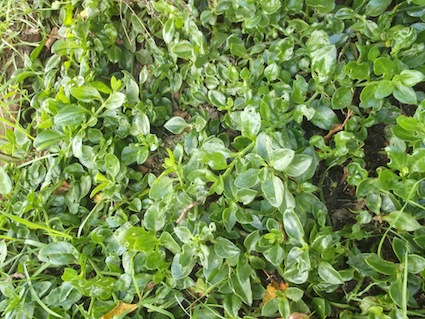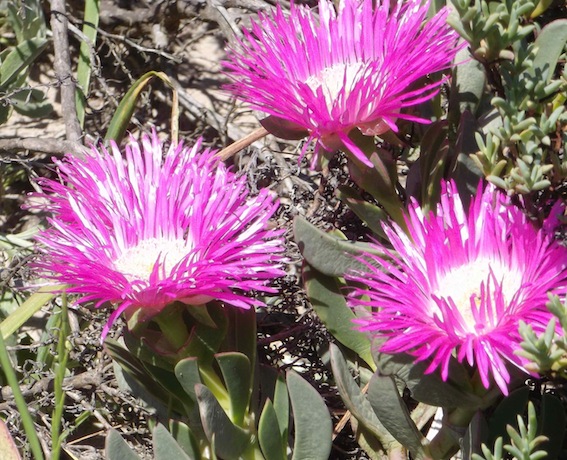Dear Reader, in this age of AI created content, please support with your goodwill someone who works harder to provide the human-made. Sign up at the top of the lefthand column or bottom of this page. You will receive my hand illustrated monthly newsletter RESTORE NATURE and access to the biodiversity garden design course as I write...and nothing else, I respect your time. I am also removing the advertizing as best I can as its become intrusive inappropriate and pays me nothing.
foraging in the fynbos
Foraging in the Cape Fynbos has its dangers and delights, as can be seen in the section on safety while foraging on the food from nature page. Below is an description of how
to use some of the plants you can forage locally, bearing in mind that you should not only take care for your own safety, but minimize your impact on the plant when foraging, and respect limitations on where you can collect, which are also on the food from nature page under the heading ecological precautions. Loubie Rusch is a landscape designer turned activist for indigenous foods, who has experimented extensively with the use of these in creative new ways, (bravely, might add) and has helped establish a number of wild food gardens on the Cape Flats. She can be found on the facebook page Making KOS. According to Loubie Rusch, some of the best plants for exploitation as edibles belong to the edible green carpet category… salads, herbs and other green parts
foraging tips from one of our greatest experts on food from nature in the cape floral kingdom
whose bearing plants grow close to the ground. Some grow from seed and others have long runners which spread out when there is plenty of water, and dry up in the summer.
Loubie ran through an astonishing list of thirty plants during her talk on gourmet foraging which I attended recently. She states that this is just the ‘tip of the iceberg’. Further research on the internet, informed me that the original inhabitants of the Cape who had lived here for thousands of years, the Khoekhoe, made use of about five hundred indigenous plants for medicines, food and other purposes like dwelling construction. I studied the Khoekhoegowab dictionary for my Master’s project, and I can confirm the astonishing diversity of vocabulary for plants and culinary processes evidenced therein.
It seems obvious that when exploiting any of these plants commercially, to be ethical, the descendants of the Khoikhoi should be considered, recompensed, acknowledged or involved in the development of new knowledge in some way. However, this doesn't always happen. Stealing our plant material for commercial nurseries in Europe and Japan and the US, is an ethically repulsive thing to do.
Let us return to the carpets of green edible food growing at the Cape. These often thrive in deep sand, in the coastal dunes. The following are taken from my lecture notes on Loubie Rusch’s talk on 17th May 2016. Please see the page on using indigenous plants safely first, before you put yourself in any danger.
Tetragonia decumbens (dune spinach) is the same family as New Zealand spinach. Its perennial, sending out long runners in winter. You can eat it cooked or raw.
Mesembryanthemum crystallinum (ice plant, soutslaai, springbok slaai) or plants in the same genus are found countrywide. It grows in the dunes of the Cape and keeps reseeding itself. Loubie recommends preparing it with brown millet or sorghum, or making a salsa with chilli and apple, or a green gazpacho. The seeds can also be used.
Dasispermum suffruticosum (sea parsley) is a perennial that grows on the dunes, use it chopped in salad, for flavouring shellfish sauces combined with surings and wild garlic.
Oxalis pes-caprae (suring) are mouth wrinklingly sour. Use them in waterblommetjie bredie, and sauces to replace lemon. Bear in mind they have high oxalic acid content, and should just be used to flavour, not as a main dish, because oxalic acid can cause kidney stones.
Trachyandra ciliata (veldkool) grows along the road in Plumstead and Athlone. Pick the asparagus like flower shoot before flowering. It is a superior quality food. When irrigated it grows and crops right through the summer. Lightly steam the shoots and put in salad, or stir fry with beans and bacon, use in bredies, soup (with potato and leek perhaps) and you can use the green seeds in risotto.
Trachyandra divaricata (sandkool) grows everywhere in Khayelitsha. It is a pioneer in disturbed soil.
Carpobrotus edulis (suurvy) is well known as a food and medicinal plant. But Loubie pushes the envelope of its uses in her gastronomic experiments. She squirts the seed pulp of green fruits as a dressing over baked aubergine topped with yoghurt. She pickles the green fruit, with salt and vinegar pickling, sectioning them so one sees the beautiful star shaped seed chambers in pickles with kelp, onions, kraai bessies and dune celery seeds. She pickles the leaves with carrots, makes chutney with the dried fruit, soaking them and adding onion and lemons, and makes an aubergine-sour fig chutney too.
Asparagus sp. They are all edible but Loubie suspects the seeds of one species gave her instant heartburn on an empty stomach. Some of the shoots are bitter, the seeds can be very bitter, but A. falcatus has big sweet shoots. In our climate the intensity of alkaloids and other plant chemicals is very situation specific. They are byproducts of photosynthesis. A hot dry summer and full sun can concentrate them in the plant making the same species unpalatable, or poisonous or not, depending on locality.
Salicornia sp. (samphires) are coastal march plants growing up to 10 km inland. Blanch them with green beans. They are salty and farmed for food in Israel.
This is really incredible knowledge to share. Opening a door into bounty that has always been there. I will post my other lecture notes on the berries and seeds that can be harvested from indigenous bushes and trees on another page.
AN EDIBLE GREEN CARPET OF AFRICAN VEGETABLES
 Dorotheanthus mazoo
Dorotheanthus mazooI've spoken before of lawn replacement with Dorotheanthus, see below, an indigenous succulent of a deep emerald green foliage. Imagine if you had such a lawn replacement, needing no watering, no fertilizing, and forming a gorgeous varied green carpet that you could
eat. Carpobrotus edulis with the purple flowers, above, and the other dune vegetation that produce salads and edible greens would also provide these bonuses ! Notably, wherever you live in the world, you would do this with your local plants. Carpobrotus edulis has become an invasive menace in other parts of the world.
------
home page for links on eco wise gardening and inspiration
------
many topics on green gardening and vegetable growing
------
foraging wild African foods is ancient histora at the Cape
------
wild berries and edible seeds found locally
------
vegetable gardening the natural low cost way
------
food from nature in the Cape Floral Kingdom
------
Loubie Rusch's Making KOS page on facebook
Restore Nature Newsletter
I've been writing for four years now and I would love to hear from you
Please let me know if you have any questions, comments or stories to share on gardening, permaculture, regenerative agriculture, food forests, natural gardening, do nothing gardening, observations about pests and diseases, foraging, dealing with and using weeds constructively, composting and going offgrid.
SEARCH
Order the Kindle E-book for the SPECIAL PRICE of only
Prices valid till 30.09.2023
Recent Articles
-
garden for life is a blog about saving the earth one garden at a time
Apr 18, 25 01:18 PM
The garden for life blog has short articles on gardening for biodiversity with native plants and regenerating soil for climate amelioration and nutritious food -
Cape Flats Sand Fynbos, Cape Town's most endangered native vegetation!
Apr 18, 25 10:36 AM
Cape Flats Sand Fynbos, a vegetation type found in the super diverse Cape Fynbos region is threatened by Cape Town's urban development and invasive alien plants -
Geography Research Task
Jan 31, 25 11:37 PM
To whom it may concern My name is Tanyaradzwa Madziwa and I am a matric student at Springfield Convent School. As part of our geography syllabus for this
"How to start a profitable worm business on a shoestring budget
Order a printed copy from "Amazon" at the SPECIAL PRICE of only
or a digital version from the "Kindle" store at the SPECIAL PRICE of only
Prices valid till 30.09.2023








